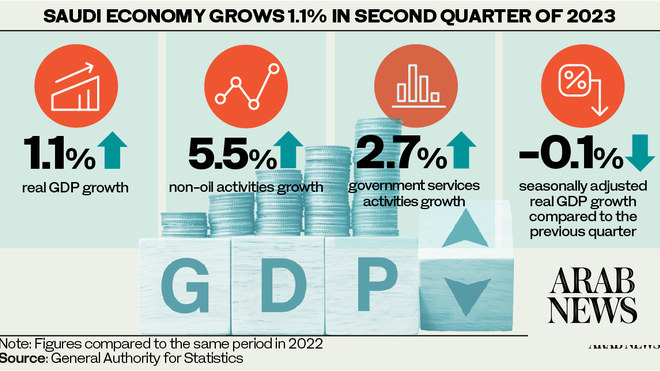
‘New export orders also recovered after contracting in September, reflecting increased external demand’
The October PMI also showed a marked improvement in optimism among non-oil businesses
DUBAI: Saudi Arabia’s non-oil economy managed to record an uptick in October, thanks to higher employment and growth in new orders because of increased demand from overseas, according to the latest purchasing managers’ index.
The headline Emirates NBD Purchasing Managers’ Index (PMI) – a composite indicator designed to give an overview of operating conditions in the non-oil private sector economy – rose slightly to 53.8 in October from 53.4 in September. A reading above 50 indicates that the non-oil economy is growing, while a reading below 50 suggests a contraction.
“New export orders also recovered after contracting in September, reflecting increased external demand. However, output rose at the slowest rate since April, suggesting that the rise in new work has yet to feed through to actual output,” Khatija Haque, the head of Middle East and North Africa research at Emirates NBD said in the report.
On a year-to-date comparison, Haque said the data suggests “that non-oil sector growth has been slower than in 2017” although such weakness was “likely to be offset by stronger oil sector growth, as the Kingdom ramps up oil production.
The employment index rose to 51.3 in October from 50.7 in September, the highest reading since March, although it actually translated to a minimal increase in employee placements as only 3.1 percent of the private sector firms in the survey reported hiring more staff last month.
“Staff costs, a good proxy for wages, remained below the neutral 50-level for the second month in a row, pointing to fractional wage deflation on average in the private sector,” Haque said.
The October PMI also showed a marked improvement in optimism among non-oil businesses with nearly half of all firms surveyed expecting their output to be higher in a year’s time, while the other half maintaining their current levels of production.
“The rise in Brent oil prices to over $80 per barrel on average last month – the highest level since October 2014 – likely contributed to improved business sentiment, and the government also signaled increased budget spending in 2019 in its pre-budget statement released in October,” Haque said, at the same time keeping the 2 percent GDP growth forecast for the Kingdom this year.
Meanwhile, the UAE’s non-oil private sector performance dipped slightly to 55 in October from 55.3 the previous month.
“It has been broadly stable between 55 and 56 for the last four months, indicating growth in the UAE’s non-oil private sector at a similar rate to last year, when official GDP data showed the non-oil sector expanded 2.5 percent,” Haque said.
The Egyptian PMI slipped to 48.6 in October, compared with 48.7 in September, the second consecutive month of contraction for the index after a brief 50-plus performance in July and August.
“It is also the lowest reading of 2018, and the data suggests that private sector firms remain under pressure as Egypt’s IMF-sponsored economic reform program continues,” Haque commented. “That being said, the reading is still far higher than those seen at the start of the process in November 2016, and future expectations remain robust; 33% of firms expect that output will be higher in 12 months’ time, with some respondents hoping that stronger investment would bolster economic activity.”












